- la
cité de l’espace - space city
 outside outside
for
children
indoors- how to manage your visit
other facilities
background history
la
cité de l’espace - space city
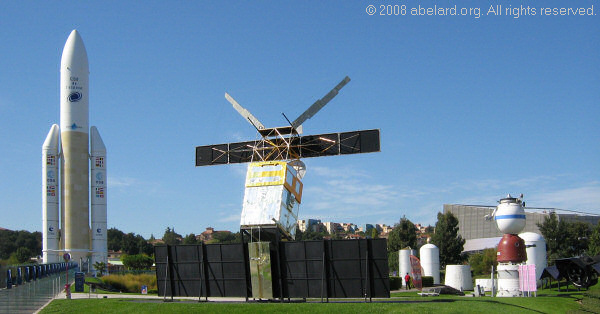
A full-size Mir space station, an Ariane 5 rocket, heart-stopping 3-D
films, absorbing (and educational) interactive displays on everything
to do with space and its exploration by humans, are presented in a neat
park with fascinating outdoor exhibits and several exhibition and cinema
buildings.
The
displays and shows at Space City can be divided into outside and indoors.
outside
  click images for larger versions
click images for larger versions
- mir space station
The Cité de l’Espace has a real space station of the first
design where humans lived for extended periods - the Russian Mir Space
Station. This particular Mir is one that had been used for thermical tests. A past newspaper report relates that it was sold to help reduce
the enormous Russian debt. Visitors can walk through the utilitarian
and small interior living and working spaces, to have a flavour of earlier
space living.
The Mir Space Station started in 1986 with a 20-ton core module, which
had six docking ports for a visiting transport craft. Further modules
added over the next decade until Mir became a space colony. It was abandoned
in 1999 because a lack of funding. The last crew comprised two cosmonauts
and a French astronaut. The Russians destroyed Mir in 2001.
-
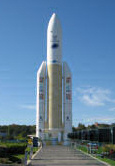 ariane
5 ariane
5
This Ariane 5 rocket is a full-size model, set in landscaping similar
to the actual Ariane launch area in Kourou, Guyana, with coconut trees
and birdsong, as well as a full rocket transport system. In the base
of the space craft is the Kids’ Space Base.
kids’
space base
Here is a hands-on exhibition aimed at 6 to 12 year-olds, organised
with three themes - Astronomer, Engineer and Astronaut. There are opportunities
to learn about time, gravity, the phases of the moon, as well as many
of the operations that are part being a spaceman (or woman), such as
building a rocket, or launching another, air-powered rocket, after priming
it up. Upstairs, there are more fascinating exhibits for young space
goers, including being inside an EVA spacesuit and
testing a space sleeping bag. It’s fascinating for adults too,
if the kids will let you have a go.
 Inside the Kid's Space Base
Inside the Kid's Space Base |
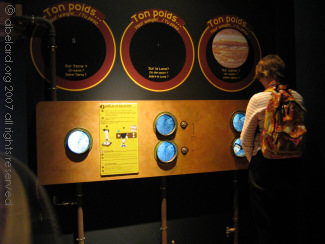 Comparing the effect of gravity
Comparing the effect of gravity |
- satellites, dishes and rocket stages
Arrayed near the entrance to the reception and exhibition building,
and between that and the Astralia building, are several satellites and
a set of stages for an Ariane rocket parading next to the path. Rather
hidden round the side is a collection of different types of parabolic
dishes for sending and receiving data signals.

Other major outdoor displays include

click image for larger version
- Our solar system: A large model shows
the relative sizes and distances of the planetary members of our solar
system. However, the size and distance scales are not comparable, so
the planets are much closer than would be correct for the relative sizes
shown in the model. All the same, the model does give a good sense of
how our closest neighbours are similar in size to the Earth, while further
away are two much, much larger planets, with the now demoted Pluto in
the distance.
- Nearby is the “alley of the infinite”.
Signs, each a metre apart, represent a geometric
sequence and demonstrate the scale of the universe. Each sign marks
a power of ten further away: 1 kilometre [100], 10 kilometres[101],
100 km [10²], 1000 km [10³] and so on, right to the edge of
the known universe - roughly 303 x 1021 km [302,736,000,000,000,000,000,000 kilometres] away. The signs include
images from space showing Space City from these distances. Soon, the
images show the whole Earth and, in due course, the solar system and
beyond.
outdoors
for children
There are plenty of other interesting bits for different ages -
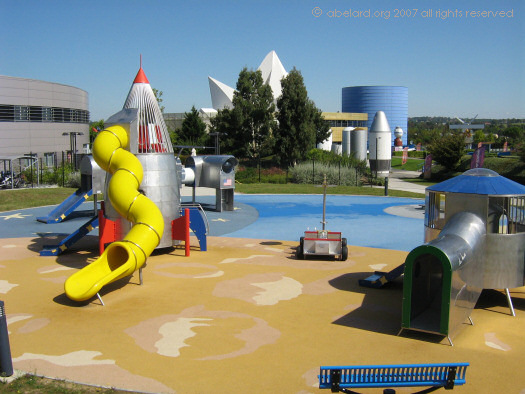
The mini astronauts' play area, suitable for
3 to 12 year olds
For younger visitors, there is a mini astronauts
play area. For a different adventure, there is the galaxy
maze.

The galaxy labarinth, suitable for 4 to 7 year
olds; with the Astralia building beyond.
Older visitors may be interested in the lane of
solar clocks - sundials, and in the large-scale demonstration
of parallax.
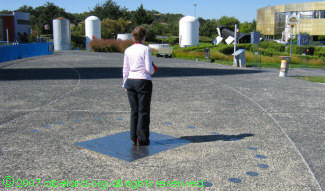
A human gnomon is part of this sundial, with rocket stages,
the galaxy maze and the Astralia building beyond.
indoors
- Terr@dome
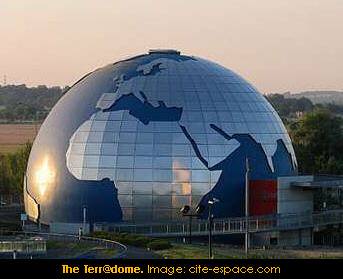 Starting
with a simulated flight into space and back billions of years, you are
guided into a vast darkened circular hall with a raised walkway that
encircles a three-dimensional globe - the Earth. Starting
with a simulated flight into space and back billions of years, you are
guided into a vast darkened circular hall with a raised walkway that
encircles a three-dimensional globe - the Earth.
The globe uses state-of-the-art retro-projection technology. 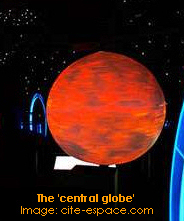 The
globe’s surface is illuminated by extraordinary projected images
that change to visualise the evolution of the Earth from its birth,
though five billion years to the present. The
globe’s surface is illuminated by extraordinary projected images
that change to visualise the evolution of the Earth from its birth,
though five billion years to the present.
The visual displays on the walls, screens below the walkway, together
with the commentary, take you through a history of the early universe,
the early solar system and, in due course, the history of our world.
You will be immersed in sounds, including from your headphones, and
a multitude of visual effects - films, slide-shows, lighting and, always
in the centre, the large glowing globe evolving and changing over the
eons of its history.

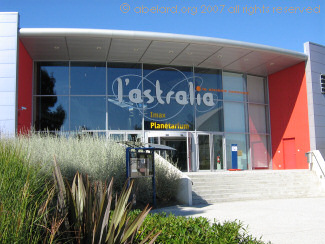
- astralia
Within this building is an IMAX cinema with
astounding films being shown at regular intervals during the day. Study
your timetable sheet carefully, it is quite easy to confuse which is
the correct door to enter at what time, mostly because the signing is
not explicit.
The IMAX cinema screen size has a enormous, 350 m² surface area
- 21m width at the base and 16m width at the top, and as high as a six-storey
building, the cinema seating 300 visitors. The room is oriented and
tilted to 22°, so you can look up without cricking your neck. abelard.org watched a very impressive film, the first 3-D film made in space, on
the building of the International Space Station. Polarised 3-D glasses
are provided to enable three dimensional viewing.
[There are two 70mm projectors providing high resolution images, about
10 times more detail than a normal 35mm film projection. The sound projection
is a Dolby-Surround system adapted to the size and shape of the IMAX
hall.]
Because it takes a good while to move audiences of three
hundred in and out of the IMAX cinema, there is a waiting
area where for the 15 minutes before the IMAX film’s
start time, another rather sweet film is shown (though
with French speech only). This screen is 14m wide and
2.6m high.
You are well advised to try and reach the IMAX cinema area well before
the film starts, to ensure that you can pick up your viewing glasses
and find a seat without fuss. The waiting room film makes any wait less
boring.
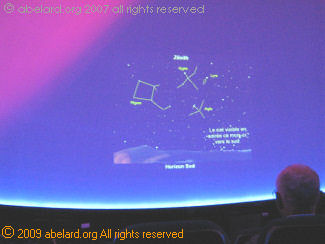
The planetarium in l’Astralia building |

The living wall in l’Astralia building,
around the entrance to the Imax cinemas |
There is also a planetarium, with a 600m²
hemispherical, overhead screen, that seats 278 people. Using high definition
videographic projection [Digistar 3], the show
flies the visitor from the outskirts of the universe and in towards
our galaxy. Later parts describe some constellations that can be seen
that evening or night. The room is inclined 10° to enable more comfortable
viewing.

how
to manage your visit
Entrance charges:
Day entrance charges [2008, price depending on season] are 19.5€
to 21€ for adults, and 13€ to 14€ for children between
5 and 15 years. There are family and individual season tickets. There
also discounts for disabled persons, unemployed, benefit recipients,
students and families of 2 adults and 2 children. Full details are available
at the Cité
de l’Espace web site [in English; French and Spanish language site versions also available].
Park plan and timetable - plan, plan, plan!
 It
is best to take a little time when you first arrive to study the park
plan and events timetable that you are given with your tickets. Several
‘shows’ or events only occur at certain times - these are
listed to the left of your park map as “access at set
times”, while others are available at any time - listed
at the map top as “permanent access”. It
is best to take a little time when you first arrive to study the park
plan and events timetable that you are given with your tickets. Several
‘shows’ or events only occur at certain times - these are
listed to the left of your park map as “access at set
times”, while others are available at any time - listed
at the map top as “permanent access”.
Initial planning will ensure that you do not miss a show or quickly
become exausted. Although there is no specified route through the Cité
de l’Espace park, a show at a specified time could be at the other
side of the park to where you are currently. Thus, some organisation
will make sure that you do not miss a showing, or spend your day cross-crossing
the park, instead of doing things more systematically.
The Cité
de l’Espace web site gives some information
about shows available (the French version has a greater
range of information), so you can do some choosing and
planning before visiting. The attendants at the information
kiosk will help as well.
- On entering the park, first study the sheet with time schedule,
park map and list of shows ( les spectacles, in French).
Take it all in together so you can work out which shows to go to,
and when and in which order. To fit in seeing lots, you will probably
want to visit over two days.
- Don’t be tempted into the souvenir
shops first, or you will miss timed displays -
keep souvenir-hunting for last, or for self-timed
visits (!) between moving around and the shows.
- Some shows are morning only, some afternoon only, some run continuously,
most are at specific times during the day.
- For a small returnable deposit, headphones (casques) are
available that receive translations of the French commentaries in
most of the shows. This is worth doing as not only are the show commentaries
in French, but many of the displays in the Exhibitions Building have
audio commentary accessible only by the headphones.
Make sure you arrive at the Cité de l’espace as early
as possible,
to have plenty of time to visit the entire site,
to programme your IMAX and Planetarium sessions,
and even be able to enjoy a guided tour during the day.
Expect to devote at least one entire day to your visit to the Cité
de l’espace.
Radio-pickup information
Visitors are provided with headphones and a receiver when they pay
a small deposit with their their entrance fee at the reception area.
There are information broadcast points around Cité de l'Espace
that send information about the nearby exhibit to the headphones. Tell
the ticket-seller your preferred language and you will be given the
appropriate receiver.
Tickets
You will use your ticket to access the different films and indoor exhibition
areas, just as you might use a metro ticket. So, do not lose the ticket,
and it’s best not bury it right at the bottom of a bag or in an
inside pocket.

other
facilities
- Two restaurants and a snack bar, as well as several picnic areas.
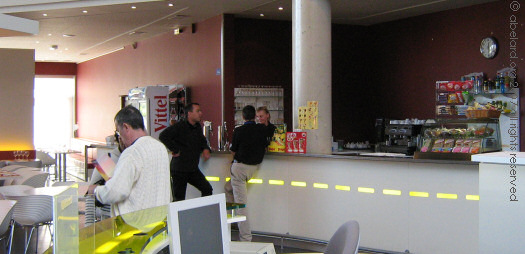
- A souvenir shop with general Cité de
l’espace items, as well as items themed to different displays
in the park. There are also regional products including Toulouse violets
and pastel. The prices of the souvenirs are within
reason.
- attractive planted areas, trees, benches, attractively arranged.
- signs are detailed, but understandable.
Near to Montaudran is a quantity of variously-priced hotels, some offering
special deals at times.
Both the Cité de l’espace and most of the hotels have
English-speaking staff, and often there are also speakers of other European
languages.
Information on current prices, opening times and shows
can be found at the Cité
de l’Espace web site, together with hotel
information and descriptions of the various technologies
used. [Note that this web site has animation, streaming
video content and .pdf documents. You will need to have
Flash (for the animations), QuickTime or RealPlayer
(streaming video player) and Acrobat installed to fully
access the Cité de l’Espace web site; available
in French, English and Spanish.]
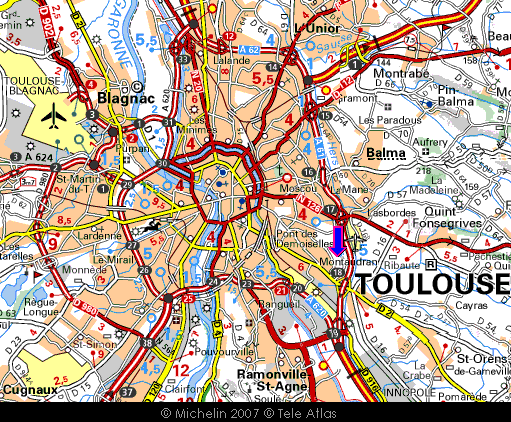
 The
Cité de l’Espace park is located off the busy A61 Rocade
(ring road) between Junctions/Sorties 17 and 18, in the southbound direction.
[Indicated on small-scale map by blue arrow. We advise you to use Sortie
17] The
Cité de l’Espace park is located off the busy A61 Rocade
(ring road) between Junctions/Sorties 17 and 18, in the southbound direction.
[Indicated on small-scale map by blue arrow. We advise you to use Sortie
17]
The Cité de l’Espace is not easy to access, and the road
signs (like so
many French road signs) are not very obvious, or explicit. Several
car parks for the theme park lead off the second roundabout, as does
a local road.
background
history
Toulouse can be regarded as the European capital of aviation and aerospace.
Over 35,000 of the city’s 400,000 population are employed in civil
aviation or space industries, with Airbus / EADS being the largest employer
in the region.
The Cité de l’Espace was opened in 1997 as a space museum,
and is now a major educational while entertaining theme park in southern
France. In October 2007, a large exhibition will opened to celebrate
both the 10th anniversary of the park and the 50th anniversary of the
launching of the first man-made object into space - the Sputnik by the
USSR (United Soviet Socialist Republic).
Roughly half its financing is from the City of Toulouse funds, as well
as contributions from the Midi-Pyrenees regional council, and various
natinal ministries and agencies. The other half of the funding is provided
by space-associated organisations, including the European Space Agency,
the National Space Study Center, Aerospatiale (the French component
of the Airbus consortium), Matra Marconi Space, as well as national
gas and electricity utilities (EDF-GDF), and Meteo France (French weather
agency).
For operating, the annual budget is about $5.5 million a year.
end notes
-
- thermical
- To do with the interactions between very high
electrical charges and objects, as when a lightning
bolt strikes a metal spaceship. At the point hit
by lightning, there is great pressure and heat generated,
with the metal melting in localised spots. [Only
information source found so far]
-
- EVA
- Extra Vehicular Activity
- The Digistar3
projection technology used in the planetarium is made
by Evans & Sutherland Computer Corporation (E&S),
based in Salt Lake City, Utah, USA. The Cité
de l’espace is their thirty-fifth customer for
Digistar3.
-
- Pastel
- Pastel is a dye plant (Isatis tinctoria),
whose colour is a pale, pastel (!), blue. It was
the dyestuff used for the French troops during World
War One, and is also much used in paints. Thus many
French country houses have their shutters and fences
painted Pastel Blue.
|
advertising
disclaimer

france
new! Cathedrale Saint-Gatien at Tours 
 updated: Romanesque churches and cathedrals in south-west France updated: Romanesque churches and cathedrals in south-west France
the perpendicular or English style of cathedral 
the fire at the cathedral of Notre-Dame de Paris

cathedral giants - Amiens and Beauvais
Stone tracery in church and
cathedral construction 
stone in church and cathedral construction stained glass and cathedrals in Normandy  
fortified churches, mostly in Les Landes
cathedral labyrinths and mazes in France
using metal in gothic cathedral construction
Germans in France
cathedral destruction during the French revolution, subsidiary page to Germans in France

on first arriving in France - driving
France is not England
paying at the péage (toll station)

Transbordeur bridges in France and the world 2: focus on Portugalete, Chicago,
Rochefort-Martrou
Gustave Eiffel’s first work: the Eiffel passerelle, Bordeaux
a fifth bridge coming to Bordeaux: pont Chaban-Delmas, a new vertical lift bridge
France’s western isles: Ile de Ré
France’s western iles: Ile d’Oleron
Ile de France, Paris: in the context of Abelard and of French cathedrals
short biography of Pierre (Peter) Abelard
Marianne - a French national symbol, with French definitive stamps
la Belle Epoque
Grand Palais, Paris


Pic du Midi - observing stars clearly, A64
Carcassonne, A61: world heritage fortified city
Futuroscope
Vulcania
Space City, Toulouse
the French umbrella & Aurillac
50 years old:
Citroën DS
the Citroën 2CV:
a French motoring icon
the forest as seen by Francois Mauriac, and today
Les Landes, places and playtime
roundabout art of Les Landes
Hermès scarves

bastide towns
mardi gras! carnival in Basque country
country life in France: the poultry fair
what a hair cut! m & french pop/rock

Le Tour de France: cycling tactics 


|
















